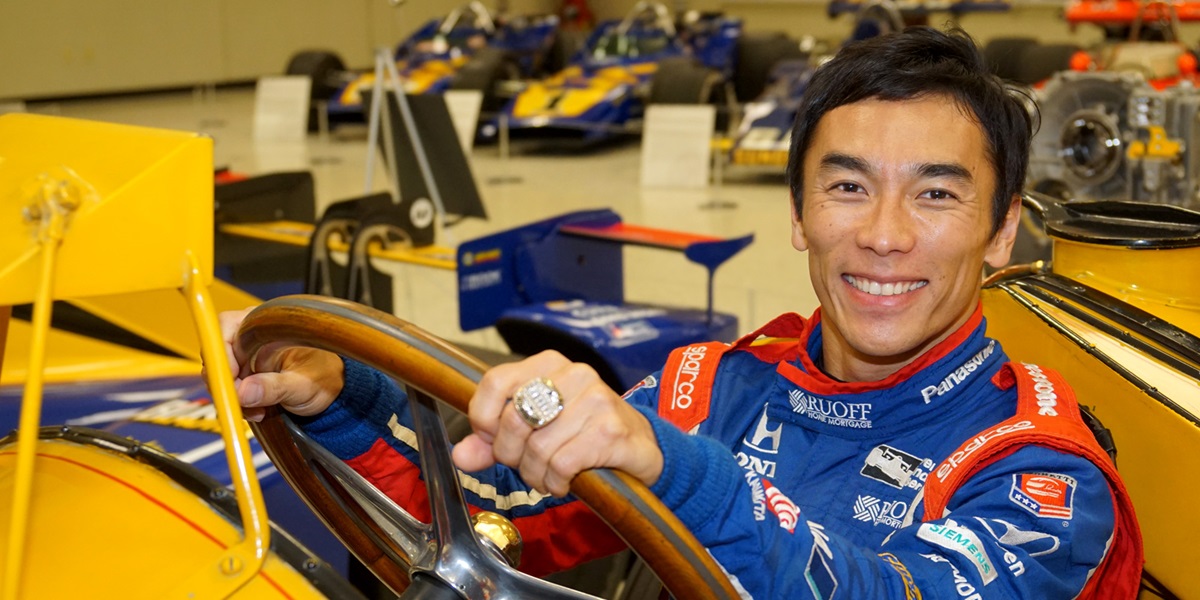
Sato Revels in Indianapolis 500 History with Marmon Wasp
October 19, 2017 | By Bruce Martin, INDYCAR
On the eve of seeing his likeness unveiled on the Borg-Warner Trophy as the latest Indianapolis 500 winner, Takuma Sato had the opportunity to sit where it all began.
Sato, winner of the 101st Indianapolis 500 presented by PennGrade Motor Oil on May 28, was at the Indianapolis Motor Speedway Museum on Monday to record a media interview a day before his sterling silver likeness was revealed on the iconic Borg-Warner Trophy. While at the museum, he had the opportunity to climb into the famed Marmon Wasp that Ray Harroun drove to victory in the first Indianapolis 500 in 1911.
The first Japanese driver to win “The Greatest Spectacle in Racing” leapt at the opportunity to get into such a historically significant machine.
“It is absolutely amazing to be able to sit in Marmon Wasp and realize this is the same car that won the very first Indianapolis 500, 106 years ago,” Sato told the Verizon INDYCAR Mobile app. “To think that these drivers drove cars this big and bulky and the entire race course was bricks for 500 miles is an incredible achievement.
“It shows the courage those drivers had back then. And to think this is the car that won the first Indy 500 is unbelievable.”
Sato was all smiles as he settled into the seat used by Harroun – and Cyrus Patschke, who relieved Harroun behind the wheel for approximately 35 laps in the middle of the race – on May 30, 2011, starting an international tradition that continues to this day.
A few inches above the huge steering wheel on the Marmon Wasp sits what is regarded as the world’s first rear-view mirror. Harroun, an automotive engineer of note in his day, devised the mirror so he could see traffic approaching from behind and eliminate the need for a riding mechanic that other drivers used to let them know when a car was getting close.
The innovation paid off with a lighter weight car. Harroun won the first Indianapolis 500 at an average speed of 74.59 mph. By comparison, Sato won this year’s Indy 500 in the No. 26 Andretti Autosport Honda with an average speed of 155.395 mph.
On Monday night, Sato looked through the Wasp’s rear-view mirror, taking in the history of the Indianapolis 500. The next day, his permanent likeness on the Borg-Warner Trophy – joining those of Harroun and every other Indy 500 winner – was shown to the public for the first time.
Following the unveiling, Scott Gallett, vice president of public relations and marketing for BorgWarner, Inc., toasted Sato and made a historic announcement. For the first time since it debuted in 1936, the Borg-Warner Trophy will travel outside the continental United States on a trip with Sato to his native Japan in December.
“We wanted to make sure we could do it safely, but it's a go and we're going to have a trophy tour in Japan,” Gallett said. “It's going to be really big. It's going to be very special.
“With the exuberance Takuma has, they really appreciate it (in Japan). They take things very seriously, especially tradition, and that is what this trophy is all about. I know it is going to be honored by the people of Japan.”
Sato is thrilled that he will get to accompany the Borg-Warner Trophy to his homeland.
“I'm very excited,” Sato said. “I really appreciate everyone making this happen and thank you, BorgWarner, for doing this. Japanese fans will get a chance to physically see the Borg-Warner Trophy. This is the first time in history (it is traveling abroad) and it is so exciting. I'm really, really, really thrilled.
“I think they will be amazed at the size of the trophy and the history of it with 104 faces on it. It's incredible and I think they will really enjoy it.”
Sato added that, during the tour, he will drive the winning car from the Indianapolis 500 at Twin Ring Motegi, where Indy cars raced from 1999-2011.
“That is also an extra bonus and I'm grateful for that,” said Sato, who will drive for Rahal Letterman Lanigan Racing in the 2018 Verizon IndyCar Series season.
In addition to being the namesake for the prestigious trophy, BorgWarner makes the turbochargers used in every Verizon IndyCar Series engine.
“We have a number of facilities in Japan and have business with every automaker on the planet already as a company,” Gallett said, “but it's something special when it comes to the trophy.”